Over the last few months, COVID-19 has fuelled temporary scarcities of some household items such as toilet roll, pasta and flour. These widely reported supermarket rushes provide a unique snapshot into a certain consumer psychology playing out during this period. Less discussed however, but equally insightful, is the recent scarcity in beginner’s sewing machines. From a quick online search, sewing machines are currently out of stock – or in very limited availability – from most major UK suppliers, as many people have sought to buy one during lockdown. The sewing machine has gone in and out of fashion over the course of its two-century existence. Its obstinate survival today, however, has allowed for an incredible boom in home-sewing activity, and the machine has arguably never been more popular. This unexpected phenomenon sheds some light into our evolving domestic behaviours and how some people are prioritising time, while emphasising the social significance of craft and the sense of community that making continues to offer despite social distancing.
The sewing machine was first introduced as a mass-produced commodity to households in America in the 1850s. It was heralded as a mechanical wonder and great labour-saving device that would transform the lives of women who were often responsible for making and re-making family wardrobes and household furnishings. However the cost of early machines was prohibitive, and in 1860, at a price of $50 to $125 (roughly $1,544 to $3,706 today), it represented a significant portion of the average family’s yearly income. This prompted I.M. Singer & Co. (later to become the sewing machine giant Singer) to introduce a hire-purchase plan that enabled households to take a machine home for $5 ($154 today). Decades before Henry Ford’s 1913 innovation of the moving assembly line, which famously brought down the price of automobiles, sewing machine companies were feverishly competing with each other to rationalise production and make their machines more affordable. Today a sewing machine can be purchased from as little as £33.00 from the likes of John Lewis, Lidl and Hobbycraft.
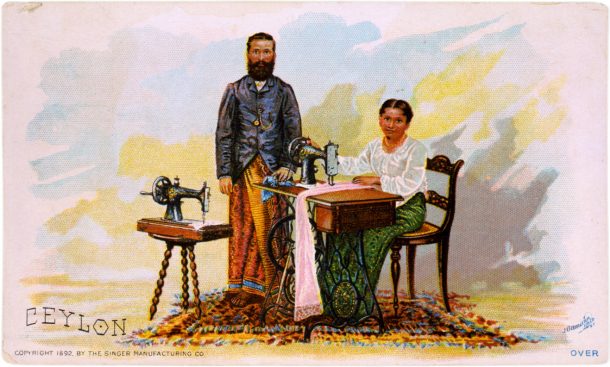
The popularity of sewing machines ebbed and flowed throughout the course of the 20th century. At first, due to its price, it was a household status symbol. With the rise of steadily cheaper ready-to-wear clothing, it waned in popularity. The World Wars gave drive to campaigns like ‘make do and mend’ reigniting the sewing machine as an essential tool; but by the 1980s onwards low-cost high-street fashion and the steady decline in school needlework lessons saw a big dent in the popularity of the skill. Since the early 21st century, home sewing has been on the rise, aided by cheaper tools and the rise of blogging and craft fairs which has made the activity more easily available and accessible to many. Concerns about climate change and the need to find alternatives to fast fashion has prompted many to start making their own clothes, while the BBC’s The Great British Sewing Bee (first aired in 2013) has further fuelled the popularity of the craft. Incidentally the sixth series of the show returned to popular acclaim on 22 April, one month into the UK’s lockdown.
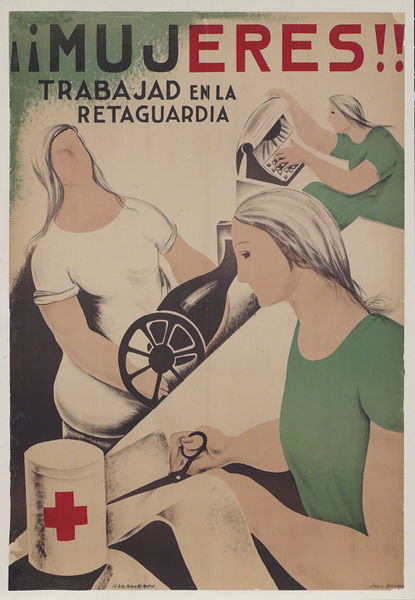
For those fortunate enough to be able to stay at home and with time on their hands, this has created opportunities to explore different craft skills. Livia Turnbull writes about one pursuit, making home-made masks here. ‘Making’ is widely advocated as a tool for mindfulness and good mental health, and more than ever people are turning to it as a calming antidote to the stress of the current global crisis. As a result, the craft sector is flourishing. Hobbycraft, the UK’s biggest arts and crafts retailer, have reported that visits to their website have tripled since lockdown and the sale of sewing machines has gone up by 155%.
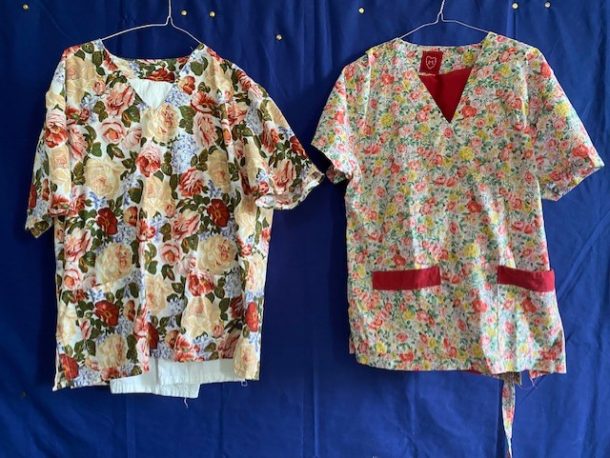
Mindfulness aside, the boom is also linked to phenomenal grassroots campaigns that have seen the sewing machine become an essential tool in combatting the virus. COVID-19 has prompted increased infection control measures and so the increased turnover of vital PPE and protective clothing has created a global scarcity. To help combat this, numerous volunteer groups such as the ‘For the Love of Scrubs’ Facebook group and the website ‘Scrub Hub’ were set up throughout March and April to bring together sewers and coordinate efforts to supply the NHS and other frontline health workers with scrubs during the crisis. Sewers have been using readily available online templates to craft scrubs from unused or unwanted materials, including curtains, children’s bedding and linen, to create unique scrubs for frontline workers. Organisations such as the Royal Hospital for Neuro-Disability in Putney specifically asked volunteers to prioritise bright colours and patterns to bring some much needed cheer to the hospital corridors and community.
The voluntary campaign has seen thousands of scrubs donated as part of this national effort. It has also brought together a diverse network of sewers including local community groups, costume makers at the English National Opera, individual home sewers, and fashion designers such as Phoebe English, who has set up the Emergency Designer Network. In contrast, prior to the lockdown, policymakers were keen to trumpet the so-called fourth industrial revolution, where in part, new digital manufacturing hardware – 3D printers, CNC mills, and laser-cutters – would herald a new era of flexible and geographically distributed production. Such technologies, would, in theory, be invaluable to the problems of scarcity we’re facing today. And while these technologies have been employed, it is the humble sewing machine that has emerged as one of the most effective tools, this regard. The scale of the pandemic has left many people – particularly those who are not already frontline workers – feeling helpless; the sewing machine has become an avenue by which ordinary people can make a significant contribution to this global emergency or simply find solace in the act of making.
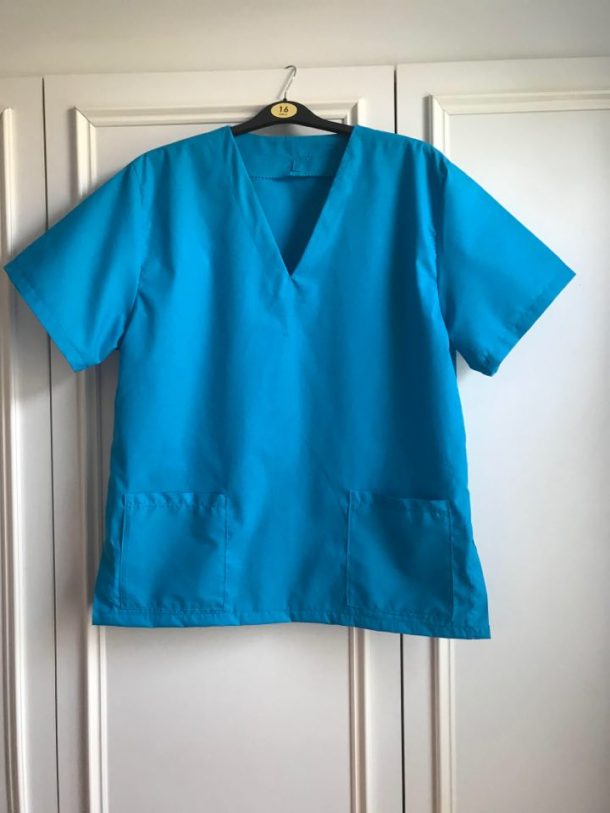
Further reading
- A good yarn: UK coronavirus lockdown spawns arts and craft renaissance, Zoe Wood, The Guardian, 4 May 2020.
- Scrub Hub website
- Coronavirus: Volunteers help protect NHS workers, Video Journalist Ed Elmsley, BBC, 2 April 2020.
- A stitch in time – new era for home sewing, Zoe Wood, The Guardian, 27 January 2017
- The Network of British Fashion Designers Making Scrubs for the NHS, Jack Moss, AnOther Magazine, 21 April 2020.
Related objects from the collections
New Family’ sewing machine (model 12/12K)
The ‘New Family’ sewing machine was one of the earliest domestic sewing machines and was introduced to the market by the Singer Manufacturing Company in 1865. Isaac Merrit Singer (1811-75) filed the patent for his first sewing machine in 1851. It was not the first sewing machine to be invented, but was an improvement on earlier machines as it combined a vertical needle with a horizontal sewing surface. This machine has a portable plywood cover which made it easier to take care of and use at home.

This dress was made for a little girl called Jane by her mother in 1942 after an unexpected invitation to a children’s party. By this stage of the Second World War, parties were unusual as there were significant food shortages and many children had been separated from family and friends after being evacuated. In addition a new party dress would have been difficult to obtain as clothing was rationed and cost money as well as precious coupons. The night before the party Jane’s mother collected every spare scrap of fabric she could find and in the morning Jane’s patchwork party dress was ready.

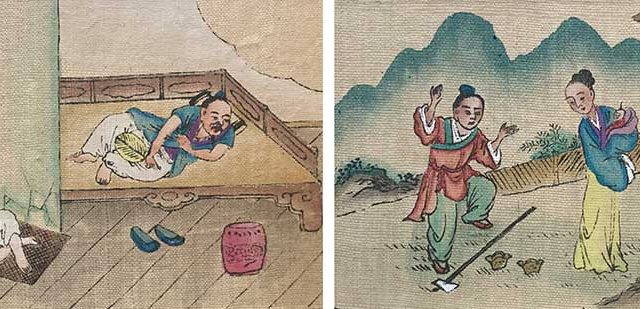

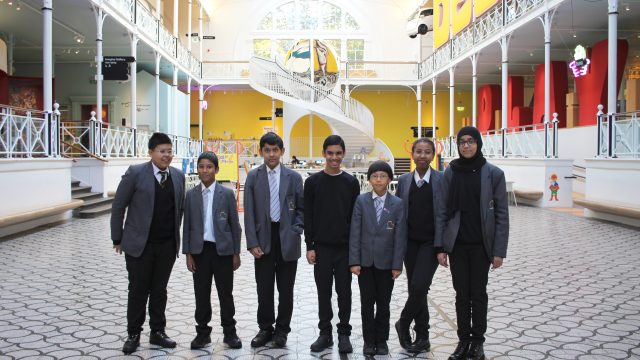
It is clear from my social media contacts that many people are indeed dusting off their machines, and I am impressed that the V&A are recording the details of our lockdown lives in this way. I would argue that people with home 3D printers have been making a similar contribution to the production of visors. Finally, after making a number of masks without having to piece together scraps, I am stunned by the achievent of Jane’s mother in producing a whole dress overnight!
Lovely piece, enjoyed it. Learned to use my Mothers treadle Singer sewing machine when I was 4 years old.
Back in the 70s in Dublin it was popular to have an old pair of highheel shoes belonging to your bridesmaid to be taken to the shoe makers and covered with the same fabrick as the bridesmaids dress.
My sister and I were lucky enough to be given all the left over silks, satins etc. which we used to make clothes for our Cindy dolls. Great days indeed.
The ready availability of reasonably priced simple sewing machines has facilitated both beginners and those, like myself, who learned to sew as a child and have often thought of taking it up again in later life, but were intimidated by the complexity and expense of modern sewing machines. I bought my John Lewis basic machine following a request from a local nurse to make laundry bags. Many isolated older people have relished the chance to brush off old skills and learn new ones and have particularly appreciated the opportunity to do something useful and contribute to the national effort for health workers. We are not allowed to go out and help. My mother was a nurse in London in WWll and a highly skilled needlewoman, making all our clothes on a treadle machine. I have felt thankful to be honouring her memory in joining the effort to help the NHS.
There are 2 groups out there making scrubs – For the Love of Scrubs which is based on Face book and started in March 2020 & The Scrub Hub . Don’t know much about Scrub Hub. Both very much deserve a mention. The pattern was adapted to make it simple and quick to make up by a online pattern maker called Laura who runs a website called Sew Different. She made the pattern available for free and as far as I am aware from looking at all the Scrubs makers it is the one they use. Also many fabric online sellers have helped out with donated fabrics for the various groups. The NHS Scrubs makers are far and wide and amazing people. Sad all this was not added to your article on Sewing & the Pandemic.
I joined Singer as a representative in1967.Visiting customers homes by invitation no cold calling.Singer trained us to service/repair sewing machines and to show respect on home visits.It was a sad day to learn Singer was to close all world wide factories including Clyde Bank.Singer trade name was second to Coca Cola.Singer sold its valuable trade name.I closed one of the last Singer shops Long Row Nottingham Then opened my Franchise Singer in main Centre Derby 1984. I am still trading,shop Ilkeston Sewing Centre been their 33years mainly because low rent.However I have a great deal to thank Singer for…..
What an interesting, informative article.
My father bought my mum her first sewing machine, a Singer, in the 1950’s when we were living in North Africa. She made all our clothes which made us the envy of many, especially because of the beautiful fabrics from the local market. I wonder if people will keep up sewing when the pandemic is over….
Sales of beginner sewing machines have surged – so too, the overlocker. I know of three people who rushed to buy one in preparation for joining the sewing effort and JL’s cheaper model is currently out of stock. Many have embraced the opportunity to get to grips with this machine as a result of sewing scrubs, headbands etc. Several of our team relished the time and the opportunity to learn new techniques and solve problems in collaboration with other sewers. They now have the satisfaction that their skills have improved as a result.
There are many more than two groups out there! I’m involved with sewing4kingston which has produced upwards of 18000 bits of kit ranging from scrubs to ear savers. I have also dealt with Helping Dress Medics, a bunch of Film and TV costume designers lending their skills. This is a national movement of thousands of community groups, large and small, and needs to be recorded for posterity as – primarily women’s – social history and in case we need to mobilise again, heaven forbid. Something very important and magical is happening here, facilitated both by social media and by good old-fashioned people talking to each other on the ground and setting up organisational structures. The level of sophistication behind the scenes, galvanised in such a short time, is highly impressive.
Fabulous article Becky Knotts. I was given a singer children’s sewing machine by my dad when I was only 4 yrs old. Which I still have . Sewing is my passion and my profession. My 87 year old mum who was self isolating was the one who started making scrubs wash bags for the nhs staff, she was inundated with requests from frontline staff. I ended up helping her to get a big order of 1500 bags made, had to get help from lots of volunteers who came onboard to help.
The requests for bags, scrubs, knitted ear savers and knitted hearts are still ongoing . It’s been the most humbling experience and wonderful to see communities united with one goal in mind , to help our Nhs.
I have a really beautiful set of scrubs that I would love to donate to the museum. Can you advise me how I can do that.
Kindest Regards
Rashmi
Dear Rashmi,
Many thanks for getting in touch and sharing your experiences, and for your kind offer to donate a set of scrubs to the museum. We are already in discussions about acquiring another set of scrubs and therefore we will have to decline your offer.
Many thanks and best wishes,
Becky